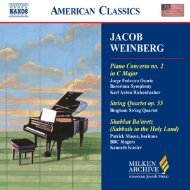Download Liner Notes PDF - Milken Archive of Jewish Music
Download Liner Notes PDF - Milken Archive of Jewish Music
Download Liner Notes PDF - Milken Archive of Jewish Music
You also want an ePaper? Increase the reach of your titles
YUMPU automatically turns print PDFs into web optimized ePapers that Google loves.
vary to different degrees among the established rites<br />
(Ashkenazi, Sephardi, Yemenite, Persian, etc.). But<br />
the surrounding texts, unlike many other portions <strong>of</strong><br />
the regular liturgy, have no specific canonized prayer<br />
modes (nusaḥ hat’filla), fixed melodies, or modalities<br />
attached to them, and they are thus an invitation for<br />
free musical interpretation and expression—whether<br />
in solo cantorial renditions, formal choral settings,<br />
congregational tunes, or a combination <strong>of</strong> all three<br />
forms. In the modern era, beginning in Europe at least<br />
as early as the second quarter <strong>of</strong> the 19th century, these<br />
prayer texts—which form and accompany the seder<br />
hotzat hatora (the order <strong>of</strong> service for removing the<br />
sacred scrolls from the ark) and the seder hakhnasat<br />
hatora (returning them to the ark), and their respective<br />
processionals among the congregation—have acquired<br />
hundreds <strong>of</strong> melodies as well as formal musical<br />
settings in a wide variety <strong>of</strong> styles; and they have been<br />
addressed by virtually every synagogue composer in<br />
each era, geographical area, and tradition <strong>of</strong> worship.<br />
In America, however, until the 1930s, composers and<br />
cantor-composers treated sections <strong>of</strong> these texts for the<br />
most part individually rather than as components <strong>of</strong> a<br />
larger single musical piece.<br />
context to become a concert rendition, especially in this<br />
orchestrated version. (In principle, the orchestration is<br />
merely an expansion <strong>of</strong> the organ part; and a handful<br />
<strong>of</strong> adventurous nonorthodox congregations have<br />
even experimented with orchestrated services.) At<br />
the same time, however, these settings—which are,<br />
by the composer’s intention, also separable from the<br />
whole as independent renditions—were composed<br />
with the equal expectation <strong>of</strong> functional use in<br />
synagogue services. Indeed, some <strong>of</strong> them are among<br />
standard repertoires in American synagogues to this<br />
day—including traditionally oriented synagogues,<br />
where they are sung successfully a cappella. Adonai,<br />
adonai, which mirrors the formal structure and flavor<br />
<strong>of</strong> earlier classical European settings <strong>of</strong> this text—most<br />
notably, that <strong>of</strong> Avraham Moshe Bernstein (1866–<br />
1932)—without compromise to artistic originality, is<br />
undoubtedly the best-known movement <strong>of</strong> The Holy<br />
Ark. It remains, along with Bernstein’s composition,<br />
one <strong>of</strong> the most frequently sung musical versions <strong>of</strong><br />
this prayer in America, and it can be considered a classic<br />
<strong>of</strong> the American Synagogue.<br />
—Neil W. Levin<br />
The Holy Ark—Aron Hakkodesh, a formal multimovement<br />
setting <strong>of</strong> major parts <strong>of</strong> the Torah Service as<br />
a cohesive yet heterogenous and kaleidoscopic artistic<br />
expression, is one <strong>of</strong> Helfman’s most important and<br />
most enduring liturgical works. Completed in 1950, it<br />
emphasizes the dramatic elements both <strong>of</strong> the individual<br />
constituent texts and <strong>of</strong> the overall mood <strong>of</strong> this section<br />
<strong>of</strong> the Sabbath or Festival morning worship. Infused<br />
with biblical cantillation motifs (overtly, for example,<br />
in the opening setting, Ein kamokha—not included on<br />
this CD—or in Vay’hi binso’a), restrained and stylized<br />
cantorial idioms in the solo vocal lines, some actual<br />
melodic references (in particular, Va’ani t’fillati, which<br />
the composer labeled “after an old melody”), and an<br />
abundance <strong>of</strong> purely original material—all treated with<br />
harmonic imagination and fresh choral techniques—it<br />
falls partly under the rubric <strong>of</strong> sacred art music. The<br />
work as a whole thus can be viewed as exceeding<br />
the functional boundaries <strong>of</strong> the synagogue worship<br />
Texts and Translations<br />
DI NAYE HAGODE<br />
Text: Itzik Fefer<br />
Sung in Yiddish<br />
Translation: Eliyahu Mishulovin<br />
[1] NARRATOR: This is the story <strong>of</strong> a city in desolation. A<br />
city <strong>of</strong> ghostly shadows, where once Jews lived and prayed<br />
and worked. This is the story <strong>of</strong> a fateful evening, <strong>of</strong><br />
unspeakable days when Jews were huddled in the frightful<br />
subcellars <strong>of</strong> the ghetto to read again the Haggada, the<br />
ancient recital <strong>of</strong> the struggle for freedom. And when the<br />
brutal hordes <strong>of</strong> the enemy came into the ghetto with their<br />
tanks and their poison gases to exterminate them, the Jews<br />
left <strong>of</strong>f reading the Haggada and rose and met the enemy<br />
empty-handed but head-on, writing a new Haggada in<br />
their blood. This is the story <strong>of</strong> a city. This is the story <strong>of</strong> a<br />
fateful night. This is the story <strong>of</strong> the New Haggada.<br />
25 8.559440<br />
Helfman_<strong>Liner</strong>Nts 9440.indd 25<br />
12/5/05 1:03:58 PM
















